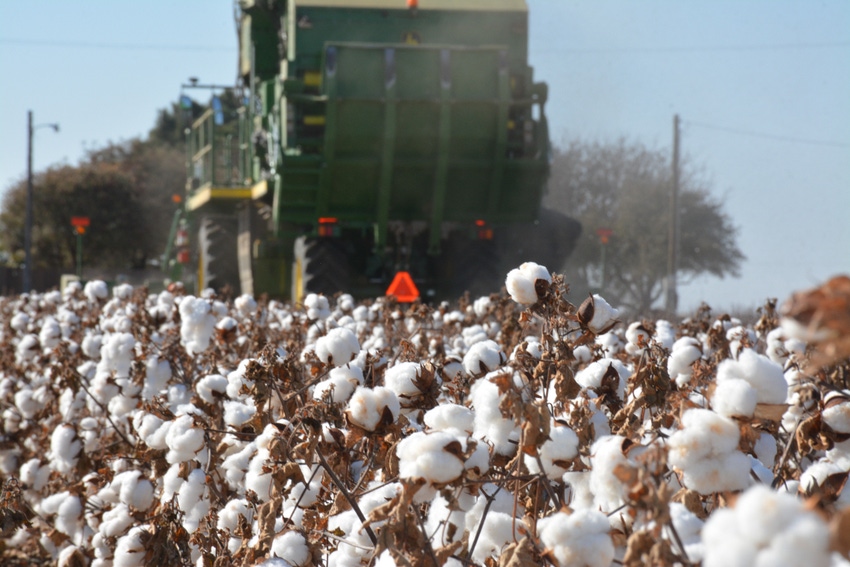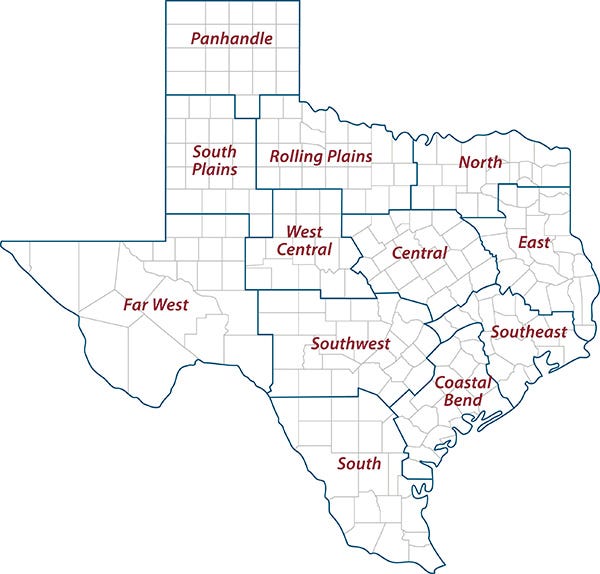
Uncertainty surrounding the spread of coronavirus has Texas cotton producers in limbo regarding their crop options for 2020, according to a Texas A&M AgriLife Extension Service expert.
John Robinson, AgriLife Extension cotton marketing specialist, College Station, said cotton prices have been dropping due to the disease’s effects on global production, manufacturing and consumption.
The ripple effect of coronavirus on the global supply chain and U.S. imports and exports is spreading, he said.
“The human toll is evident, but there’s also a lot of disruption to commerce, including to cotton,” Robinson said. “You’ve got hundreds of millions of people in Asia who are staying at home. That affects everything from ships not being unloaded to textile manufacturing and consumption.”
Uncertainty spreads with outbreak
The National Cotton Council’s prospective planting surveys suggested growers would plant 13 million acres of cotton in 2020, but prices have plunged since.
Prices fell 3-4 cents per pound in a week as the U.S. stock market dropped 1,000 points per day for three consecutive days, he said. On Feb. 27, cotton futures were down to 64 cents per pound.
Robinson said the average producer needs cotton futures prices to be around the mid-70 cent mark for any possibility of profit.
The recent U.S. Department of Agriculture cotton outlook adjusted U.S. planting expectations to 12.5 million acres. But Robinson said the extent of the coronavirus outbreak could mean further price dips and more producers looking for other planting options.
Robinson said 5.4 million bales of cotton may carry over from the 2019 growing season, which is similar to the previous marketing year. However, typical price rallies on cotton futures, which occur March through May during planting season, seem to be in jeopardy.
“I’ve never seen it like this,” he said. “How the information is changing week to week on the prices and acreage outlooks shows the uncertainty regarding how far and wide coronavirus could spread.”
Producers in limbo
Robinson said conversations with cotton growers suggests they’re not ready to commit to a crop due to the uncertainty. But options are limited for many growers in parts of the state.
Cotton acres have increased north of Amarillo over the last several years, he said. Those acres switched from corn because of irrigation limits and better cotton prices.
“Cotton is more tolerant to drier conditions, and prices helped that trend,” he said. “But now you have a lot of farmers who have invested in cotton equipment, and there’s been investment in gins. So, this has some growers in a difficult spot.”
Many dryland growers will have even fewer options because wheat and sorghum prices aren’t any better, he said.
“It may come down to which decision will lose less money,” he said. “We’re hoping the coronavirus will be a short-term problem and that there will be some positive news as we move through the planting season, but right now the unknown has everything in limbo.”
AgriLife Extension district reporters compiled the following summaries:

CENTRAL
Ground temperatures were hovering around 61 degrees, and the five-day average was finally above 50 at 51 degrees. But soil temperatures dropped to 44 degrees during a cold front. Corn plantings began and some early peach trees were budding. One morning was 27 degrees and could hurt those early buds. Later varieties were not budding. Crop and weather conditions overall were looking up with warmer temperatures. Farmers in Central Texas started planting corn. Those producers were planting 24-hours a day to get their corn planted before the forecasted rain. Pastures were sprayed and fertilized. Ryegrass grew well after the rain. Pastures greened up nicely. Wheat continued to look good. Cattle remained in good body condition as producers continued to feed hay. Stock tanks were full. Nearly all counties reported adequate soil moisture, fair crop conditions and good overall rangeland and pasture conditions.
ROLLING PLAINS
Weather conditions were mild. Winter wheat crops vary from fair to good condition. Some areas reported signs of armyworms in wheat pastures. Cattle producers continued supplementing cow/calf and stocker operations with protein and hay where forages were limited.
COASTAL BEND
Cold temperatures and much-needed rain delayed planting. Some frost was reported in central to northern counties. Any frost damage to early planted corn was still unknown. In areas where farmers could get into fields, planters were rolling with corn and grain sorghum where producers could access fields. Many were having to plant deeper to get the seed to moisture. So far, emergence was good. Pastures were affected in areas that experienced below-freezing temperatures. Winter pastures needed a soaking rain. Producers were feeding hay and protein to livestock. Cattle were in good condition.
EAST
As much as 3 inches of rain fell across the district, and more rain was expected. Sabine County reported some producers with property in the uplands were able to work their fields and were considering liming. Fields in the bottomlands were still thoroughly saturated and inaccessible. Growing conditions improved in many areas. Grasses began to green up and grow better. Pasture and rangeland conditions were good. Subsoil and topsoil conditions remained adequate. Livestock were in fair to good condition with supplemental feeding taking place. Feral hogs remained active and caused damage to pastures and hay meadows.
SOUTH PLAINS
Subsoil and topsoil moisture levels were reduced to short due to temperature changes and high winds. Temperatures were in the high 60s one day and the low 40s the next. More moisture was needed for wheat fields. Winter wheat and rangeland were in fair to good condition. Cattle were grazing on wheat and receiving supplemental feed on rangelands. Cattle were in good condition. Producers were prepping for crop plantings.
PANHANDLE
Parts of the district received some moisture. There was very little farming activity due to wet conditions in some areas. Winter wheat was progressing, and wheat field conditions were poor to good. Pasture and rangeland subsoil and topsoil moisture were short to adequate. Southeast areas reported short subsoil and topsoil moisture. Rain and warmer weather were needed to get pastures back on track. Wheat and pasture conditions will need to improve soon to improve cattle body conditions. Limited irrigation was provided to wheat fields in an attempt to promote grazing for livestock.
NORTH
Topsoil moisture levels were mostly adequate. Up to 0.5 of an inch of rain was reported. Temperatures were seasonal, but some areas received a hard freeze, which knocked back some early blooming plants. Strong winds in some areas dried topsoil moisture. Winter wheat was doing well but some fields showed signs of stress from excess water. Corn planting was around the corner, but many fields need to dry before heavy equipment can access fields. Producers reporting early issues with filamentous algae in ponds, likely due to long, warm periods followed by hard freezes. Livestock were in good condition, and spring-born calves were arriving daily. Feral hogs were active.
FAR WEST
Temperatures averaged highs in the low 70s with lows in the upper 20s. No precipitation was reported. Wind gusts were up to 40 mph. Ground preparation for planting continued. Winter wheat and oats were not heading out yet. Pecan orchards were being pruned and floors prepared for irrigations in March. Some fields were turned over, but moisture in the ground was preventing proper turning. Livestock conditions were fair to good. Growth of summer weeds increased though rangeland and pastures were still extremely dry. Livestock in drier areas needed some supplemental feeding.
WEST CENTRAL
Some areas continued to experience dry conditions while others reported good moisture. Weeds continued to emerge, and producers were busy scouting and spraying where necessary. Wheat/oat pastures were expected to progress with lots of sunshine and mild to warm temperatures in the forecast. Chances of rains were also predicted. Stock tanks caught some runoff, but still needed more water heading into spring. Light calves were steady to $3 per hundredweight lower, while yearlings were $6-$8 lower per hundredweight at local markets. Supplemental feeding was heavy.
SOUTHEAST
On and off rains were continuous in some areas. Producers were trying to work rice fields for planting but were delayed. Unseasonably warm temperatures were reported by Brazos County. Rangeland and pasture ratings were excellent to very poor with good being most common. Soil moisture levels ranged from adequate to very short with adequate being most common.
SOUTHWEST
Colder temperatures were reported across the district with northern counties reporting temperatures in the low 20s. Moisture conditions declined overall with no significant rainfall reported. Corn planting began. Rangeland and pasture ratings varied from good to poor with good being more common. Spring lambing and kidding continued, and most were in good condition. Livestock and wildlife were in fair condition with continued supplemental feeding. Cattle and goat prices were fair.
SOUTH
Mild weather conditions and short to very short soil moisture levels were reported. Wheat and oat fields were in fair to good condition, and some early planted fields were starting to head. Soil was being prepared for planting, but the lack of rain was delaying seeding. A freeze pushed back strawberry production a little. Some freeze damage to potato fields was also reported. Corn and grain sorghum planting started in some areas and was wrapping up in others. Pasture and rangeland conditions were poor due to lack of rainfall. Supplemental feeding continued for all wildlife and livestock. Some producers were hauling water and culling cattle herds.
Hay stocks continued to dwindle, and bale prices were rising. Several days of slow, steady drizzle provided some moisture in Zapata County, but much more moisture was needed for pastures and crops. Irrigated vegetable fields were being planted while others were being prepared. Coastal Bermuda grass was slowly greening. Producers in Zavala County were applying pre-planting irrigation for corn and sorghum. Dryland producers were waiting for moisture to plant. Spinach fields were in good condition, and harvest continued due to market demand. Producers started planting cotton. Vegetable crops continued to look good, and onions were close to being harvested. Producers were down the home stretch with grain sorghum planting as well.
Source: is AgriLife TODAY, which is solely responsible for the information provided and is wholly owned by the source. Informa Business Media and all its subsidiaries are not responsible for any of the content contained in this information asset.
About the Author(s)
You May Also Like




